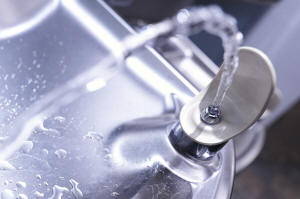Utah bans fluoride in public drinking water, a first in the US
[March 29, 2025]
By MATTHEW BROWN, HANNAH SCHOENBAUM and MEAD GRUVER
SALT LAKE CITY (AP) — Utah has become the first state to ban fluoride in
public drinking water, pushing past opposition from dentists and
national health organizations who warn the move will lead to medical
problems that disproportionately affect low-income communities.
Republican Gov. Spencer Cox signed legislation Thursday barring cities
and communities from deciding whether to add the mineral to their water
systems.
Florida, Ohio and South Carolina are considering similar measures, while
in New Hampshire, North Dakota and Tennessee, lawmakers have rejected
them. A bill in Kentucky to make fluoridation optional stalled in the
state Senate.
The American Dental Association sharply criticized the Utah law, saying
it showed “wanton disregard for the oral health and well-being of their
constituents.”
Cavities are the most common chronic childhood disease, the ADA noted.
Fluoride strengthens teeth and reduces cavities by replacing minerals
lost during normal wear and tear, according to the U.S. Centers for
Disease Control and Prevention.
“As a father and a dentist, it is disheartening to see that a proven,
public health policy, which exists for the greater good of an entire
community’s oral health, has been dismantled based on distorted
pseudoscience,” the association’s president, Denver dentist Brett
Kessler, said in a statement.
Is fluoride unhealthful? Some lawmakers say it is
The ban, effective May 7, brings into the mainstream concerns over
fluoridation that for decades were considered fringe opinions.
It comes weeks after water fluoridation skeptic Robert F. Kennedy Jr.
was sworn in as U.S. health secretary. Kennedy said in November that the
administration of then-presidential candidate Donald Trump would advise
water systems nationwide to remove fluoride.
Cox, who grew up and raised his own children in a community without
fluoridated water, compared it recently to being medicated by the
government. Utah lawmakers also said the ban was a matter of personal
health choice and that putting fluoride in water is too expensive.
Florida’s surgeon general last year recommended against community water
fluoridation because of what he called its “neuropsychiatric risk.” That
guidance came after a federal judge ordered the U.S. Environmental
Protection Agency to regulate fluoride in drinking water because high
levels could pose a risk to the intellectual development of children.
Federal officials determined last year “with moderate confidence” that
there was a link between higher levels of fluoride exposure and lower IQ
in kids. But the National Toxicology Program based its conclusion on
studies involving fluoride levels at about twice the recommended limit
for drinking water. The amounts of fluoride that can be added to water
based on federal guidelines are below levels considered problematic,
Kessler said.
It’s nearly impossible to get a toxic dose of fluoride in water, the
NIH says
The National Institutes of Health says very high doses of fluoride that
can cause sickness are typically the result of rare accidents, such as
the unintentional swallowing of fluoride used by dentists’ offices or
supplements inappropriately given to children. The agency says it’s
“virtually impossible” to get a toxic dose from fluoride that’s added to
water or toothpaste at standard levels.
[to top of second column]
|

A public water fountain is seen Friday, March 28, 2025, in Grosse
Pointe Park, Mich. (AP Photo/Paul Sancya)
 However, communities sometimes
exceed the recommended levels because fluoride occurs naturally at
higher levels in certain water sources. In 2011, officials reported
that 2 in 5 U.S. adolescents had at least mild tooth streaking or
spottiness because of too much fluoride.
Since 2015, federal health officials have recommended a fluoridation
level of 0.7 milligrams per liter of water. For five decades before
that, the recommended upper range was 1.2 milligrams per liter. The
World Health Organization has set a safe limit for fluoride in
drinking water of 1.5 milligrams per liter.
Fluoride is considered one of the greatest health achievements in
100 years
The addition of low levels of fluoride to drinking water has long
been considered one of the greatest public health achievements of
the past century: one of the most cost-effective ways to prevent
tooth decay on a large scale.

In 1950, federal officials endorsed water fluoridation to prevent
tooth decay, and they continued to promote it even after fluoride
toothpaste brands hit the market several years later. More than 200
million people in the U.S., or almost two-thirds of the population,
receive fluoridated public water.
Fluoride in drinking water can reduce cavities by at least 25% for
all age groups, according to the Utah Dental Association. Opponents
of the Utah legislation to limit fluoridation warn it will have a
disproportionately negative effect on low-income residents who may
rely on fluoridated water as their only source of preventative
dental care.
It's a matter of personal choice, Utah's bill sponsor says
The sponsor of the Utah legislation, Republican Rep. Stephanie
Gricius, acknowledged fluoride has benefits, but said it was an
issue of “individual choice” to not have it in the water.
Out of the 484 Utah water systems that reported data in 2024, only
66 fluoridated their water, an Associated Press analysis showed. The
largest was that in the state’s biggest municipality, Salt Lake
City.
Utah in 2022 ranked 44th in the nation for the percentage of
residents that receive fluoridated water, according to the CDC data.
___
Brown reported from Billings, Montana. Gruver reported from
Cheyenne, Wyoming.
All contents © copyright 2025 Associated Press. All rights reserved |